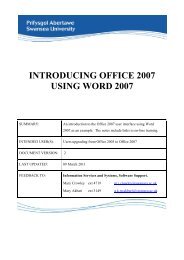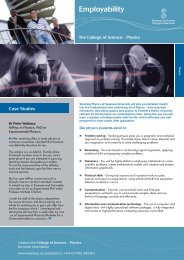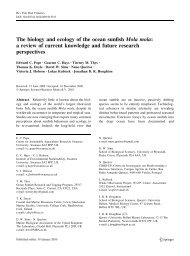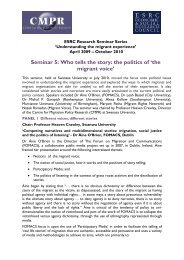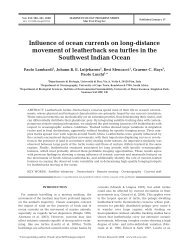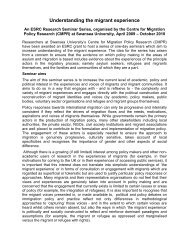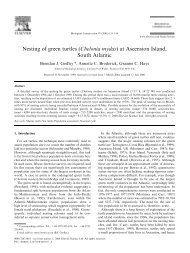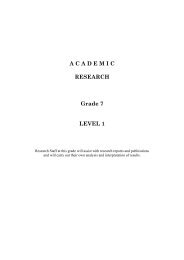The energy density of jellyfish - Swansea University
The energy density of jellyfish - Swansea University
The energy density of jellyfish - Swansea University
Create successful ePaper yourself
Turn your PDF publications into a flip-book with our unique Google optimized e-Paper software.
240 T.K. Doyle et al. / Journal <strong>of</strong> Experimental Marine Biology and Ecology 343 (2007) 239–252<br />
are regularly seen in areas where <strong>jellyfish</strong> are abundant<br />
at the surface, and have been observed to consume up to<br />
200 kg <strong>of</strong> <strong>jellyfish</strong> a day (Duron, 1978; James and<br />
Herman, 2001; Houghton et al., 2006b). Other examples<br />
<strong>of</strong> predators now known to prey on <strong>jellyfish</strong> include<br />
many arthropods, fish and birds (Arai, 2005); however,<br />
their importance as prey items does not end in the<br />
pelagic realm. Recent research has shown that large<br />
aggregations <strong>of</strong> moribund <strong>jellyfish</strong> may be important<br />
vectors for carbon transport to the deep sea in many<br />
areas <strong>of</strong> the world ocean with <strong>jellyfish</strong> detritus possibly<br />
acting as a good food source for benthic fauna (Billett<br />
et al., 2006). Furthermore, considering that <strong>jellyfish</strong> may<br />
become more important in some marine systems as a<br />
result <strong>of</strong> climate change and/or overfishing (Mills, 2001;<br />
Lynam et al., 2006), their overall ecosystem impact as<br />
prey (and predators) may similarly increase. Unfortunately,<br />
as the <strong>energy</strong> <strong>density</strong> <strong>of</strong> <strong>jellyfish</strong> is relatively<br />
poorly documented when compared to other pelagic<br />
taxa (Arai, 1997), constructing bioenergetic models for<br />
species that prey on <strong>jellyfish</strong> (Davenport, 1998; Lynam<br />
et al., 2006; Wallace et al., 2006), and trophic dynamic<br />
models that incorporate <strong>jellyfish</strong>, may be problematic.<br />
<strong>The</strong> lack <strong>of</strong> information on the <strong>energy</strong> <strong>density</strong> <strong>of</strong><br />
<strong>jellyfish</strong> is partly caused by methodological problems<br />
associated with the high salt content, high water content<br />
(95–98% wet mass) and extremely low <strong>energy</strong> <strong>density</strong><br />
<strong>of</strong> this group (Larson, 1986; Lutcavage and Lutz, 1986;<br />
Clarke et al., 1992; Lucas, 1994; Arai, 1997). More<br />
specifically, in proximate composition analysis, the sum<br />
<strong>of</strong> protein, lipid and carbohydrate fractions (g) are<br />
termed ‘total organics’ and taken to be synonymous with<br />
ash free dry mass (AFDM) or the mass combusted when<br />
samples are ashed in a furnace (Lucas, 1994). However,<br />
for gelatinous zooplankton there is a discrepancy or an<br />
unaccounted difference between ‘total organics’ and<br />
‘AFDM’. This difference is thought to be residual/<br />
bound water that remains in the dried <strong>jellyfish</strong>, even<br />
after drying to constant mass. <strong>The</strong> amount <strong>of</strong> ‘water <strong>of</strong><br />
hydration’ remaining after drying, was estimated to be<br />
∼11.7% by Madin et al. (1981) for salps and Larson<br />
(1986) for Aurelia aurita L. and Cyanea capillata L.<br />
This bound water, combined with a low <strong>energy</strong> <strong>density</strong><br />
may render traditional methods for estimating <strong>energy</strong><br />
<strong>density</strong>, such as bomb-calorimetry, unreliable (Lutcavage<br />
and Lutz, 1986).<br />
To tackle these uncertainties and provide baseline<br />
data for future bioenergetic studies, we compared two<br />
techniques for measuring the <strong>energy</strong> <strong>density</strong> <strong>of</strong> <strong>jellyfish</strong>:<br />
bomb-calorimetry and proximate-composition. Bombcalorimetry<br />
is relatively quick, inexpensive and thus<br />
appropriate for large sample sizes if the analytical<br />
uncertainties <strong>of</strong> this approach when applied to <strong>jellyfish</strong><br />
can be resolved. Bomb-calorimetry measures the heat<br />
liberated when ‘food/or a sample’ is combusted in a<br />
sealed chamber (the bomb) surrounded by water. <strong>The</strong><br />
heat liberated (heat <strong>of</strong> combustion) represents the food's<br />
total <strong>energy</strong> or gross <strong>energy</strong> value (GE). <strong>The</strong> second<br />
approach, proximate-composition analysis, provides<br />
more reliable estimates <strong>of</strong> <strong>energy</strong> <strong>density</strong> but is time<br />
consuming (Arai, 1997), expensive and requires much<br />
more sample material. Proximate composition measures<br />
the protein, carbohydrate and lipid content <strong>of</strong> a sample.<br />
<strong>The</strong> measured fractions are then multiplied by the<br />
combustion equivalents <strong>of</strong> these compounds. Importantly,<br />
it provides a good benchmark for assessing the<br />
reliability <strong>of</strong> bomb-calorimetry. Our aim, therefore, was<br />
to compare results derived from the same material, using<br />
both methods. We applied the techniques to three<br />
species <strong>of</strong> <strong>jellyfish</strong>, C. capillata, Rhizostoma octopus<br />
L., and Chrysaora hysoscella L., all <strong>of</strong> which are <strong>of</strong>ten<br />
abundant at high latitudes (Doyle et al., in press) and<br />
hence may play important ecosystem roles.<br />
2. Materials and methods<br />
2.1. Collection and drying process<br />
Fresh specimens <strong>of</strong> C. hysoscella (n =10) were<br />
collected from the side <strong>of</strong> a jetty in Dingle Harbour,<br />
County Kerry, Ireland (52.13°N, 10.36°W), using a dip<br />
net. Freshly stranded specimens <strong>of</strong> C. capillata (n=27)<br />
were collected from Laytown Beach, County Meath,<br />
Ireland (53.67°N, 6.23°W). <strong>The</strong>se specimens were<br />
either freshly stranded on the beach or were in the<br />
process <strong>of</strong> stranding (i.e. still in the water) when<br />
collected. Samples that were directly removed from the<br />
beach were gently dipped in a bucket <strong>of</strong> seawater to<br />
remove any sand. Fresh specimens <strong>of</strong> R. octopus<br />
(n=10) were collected from Rosslare Harbour, County<br />
Wexford, Ireland (52.37°N, 6.36°W), using a dip net. In<br />
all the above sampling events, the wet mass <strong>of</strong><br />
individual specimens was measured to the nearest<br />
gram, and the bell (umbrella) diameter measured to<br />
the nearest centimetre. Each <strong>jellyfish</strong> was then dissected<br />
into three distinct body components (or tissues): bell,<br />
oral arms and gonads. <strong>The</strong>se tissues were individually<br />
stored in plastic bags, weighed, and within 1–2 h were<br />
frozen at −20 °C. All <strong>jellyfish</strong> were collected during<br />
July–October 2004.<br />
During November 2004, samples were removed from<br />
the freezer and allowed to thaw. Samples were<br />
homogenized into a ‘jelly soup’ using a blender, and<br />
poured into pre-weighed aluminium cartons. Individual



